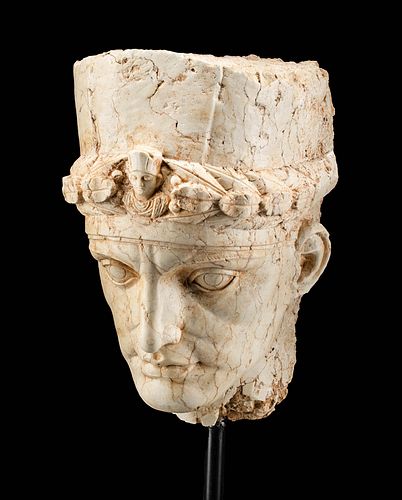Exemplary Palmyrene Limestone Head of Priest
Lot 117
About Seller
Artemis Gallery
686 S Taylor Ave, Ste 106
Louisville, CO 80027
United States
Selling antiquities, ancient and ethnographic art online since 1993, Artemis Gallery specializes in Classical Antiquities (Egyptian, Greek, Roman, Near Eastern), Asian, Pre-Columbian, African / Tribal / Oceanographic art. Our extensive inventory includes pottery, stone, metal, wood, glass and textil...Read more
Estimate:
$16,000 - $24,000
Absentee vs Live bid
Two ways to bid:
- Leave a max absentee bid and the platform will bid on your behalf up to your maximum bid during the live auction.
- Bid live during the auction and your bids will be submitted real-time to the auctioneer.
Bid Increments
| Price | Bid Increment |
|---|---|
| $0 | $25 |
| $300 | $50 |
| $1,000 | $100 |
| $2,000 | $250 |
| $5,000 | $500 |
| $10,000 | $1,000 |
| $20,000 | $2,500 |
| $50,000 | $5,000 |
| $100,000 | $10,000 |
| $200,000 | $20,000 |
About Auction
By Artemis Gallery
Oct 7, 2021
Set Reminder
2021-10-07 10:00:00
2021-10-07 10:00:00
America/New_York
Bidsquare
Bidsquare : Exceptional Antiquities Ethnographic Fine Art
https://www.bidsquare.com/auctions/artemis-gallery/exceptional-antiquities-ethnographic-fine-art-7537
Museum-worthy examples of Egyptian, Greek, Roman, Etruscan, Near Eastern, Far East / Asian, Pre-Columbian, African / Tribal, Oceanic, Native American, Spanish Colonial, Fossils, Ancient Jewelry, Fine / Visual Arts, so much more! Artemis Gallery info@artemisgallery.com
Museum-worthy examples of Egyptian, Greek, Roman, Etruscan, Near Eastern, Far East / Asian, Pre-Columbian, African / Tribal, Oceanic, Native American, Spanish Colonial, Fossils, Ancient Jewelry, Fine / Visual Arts, so much more! Artemis Gallery info@artemisgallery.com
- Lot Description
Near East / Holy Land, Palmyra, Roman period, ca. 2nd to 3rd century CE. Wow! A stunning, naturalistic limestone head of a priest wearing a characteristically tubular headdress, known as a modius, encircled by a relief wreath with a miniature male bust at the front. The ancient visage is remarkably lifelike, gazing forward from a pair of sizeable, almond-shaped eyes beneath a stern brow. His straight nose displays a narrow nasal bridge and sits just above a set of bowed lips, which gently turn up at the corners in a small smile, while a realistic pair of ears flank his head. Fleshy folds of skin across his brow, chin, and cheeks, along with angular cheek bones and slightly drooping jowls not only demonstrate the artist's remarkable ability to render life from stone, but also suggest that he may be of an older age. The details of the headdress, eyes, and ears are all beautifully preserved. Size: 18.5" L x 10.7" W x 13.9" H (47 cm x 27.2 cm x 35.3 cm); 25.3" H (64.3 cm) on included custom stand.
Note how the miniature bust atop his headdress also wears a modius; scholars posit that these armless busts that adorn the wreaths of priests functioned as symbols of the priest's rank, as a badge of clan membership, or to express connections to some ancestral cults. The limestone is beautifully marbled and crystallized, with a creamy, almost uniform color.
Palmyra was a wealthy city that linked the caravan routes from the Parthian Near East with the Roman Mediterranean; the people who lived there during this period largely enjoyed prosperity and were able to adopt eastern and western customs, clothing, and artistic styles, creating a distinctive visual culture unique to the city. We know of this culture today from the large funerary monuments that the Palmyran people built - tower-shaped vaults whose interiors were lined with sculpted limestone reliefs depicting the deceased.
Similar limestone heads of priests can be found in many famous museums throughout the world, such as The Walters Art Museum in Maryland (accession number 22.475), Museo Gregoriano Egizio of the Vatican Museums in Rome (inventory number MV.1600.0.0), and the Louvre (AO 1722, AO 5003, and AO 2065). Comparable examples have also been sold by Christie's: Christie's New York sold a limestone head of slightly less detail and smaller scale for $19,120 as lot 421 during their "Antiquities" auction (live auction 1446) on December 10th, 2004, and Christie's London sold a resemblant sculpture for 23,500 GBP (equivalent to about $32,100.18) during another "Antiquities" auction (live auction 8890) on October 5th, 2000.
This piece has been searched against the Art Loss Register database and has been cleared. The Art Loss Register maintains the world's largest database of stolen art, collectibles, and antiques.
Provenance: East Coast collection, New York Gallery, New York City, New York, USA, before 2010
All items legal to buy/sell under U.S. Statute covering cultural patrimony Code 2600, CHAPTER 14, and are guaranteed to be as described or your money back.
A Certificate of Authenticity will accompany all winning bids.
PLEASE NOTE: Due to recent increases of shipments being seized by Australian & German customs (even for items with pre-UNESCO provenance), we will no longer ship most antiquities and ancient Chinese art to Australia & Germany. For categories of items that are acceptable to ship to Australia or Germany, please contact us directly or work with your local customs brokerage firm.
Display stands not described as included/custom in the item description are for photography purposes only and will not be included with the item upon shipping.
#161470Fragment of a larger piece. Abrasions to verso. Repairs to base with break lines visible. Several stable pressure fissures, commensurate with age. Chipping throughout, most notably on ears and bridge, bridge of nose, and headdress. Otherwise, excellent with impressive remaining detail.Condition
- Shipping Info
-
All shipping is handled in-house for your convenience. Your invoice from Artemis Gallery will include shipping calculation instructions. If in doubt, please inquire BEFORE bidding for estimated shipping costs for individual items.
-
- Buyer's Premium



 EUR
EUR CAD
CAD AUD
AUD GBP
GBP MXN
MXN HKD
HKD CNY
CNY MYR
MYR SEK
SEK SGD
SGD CHF
CHF THB
THB















